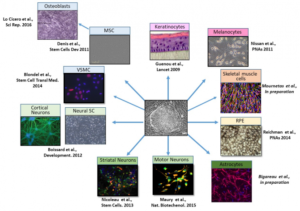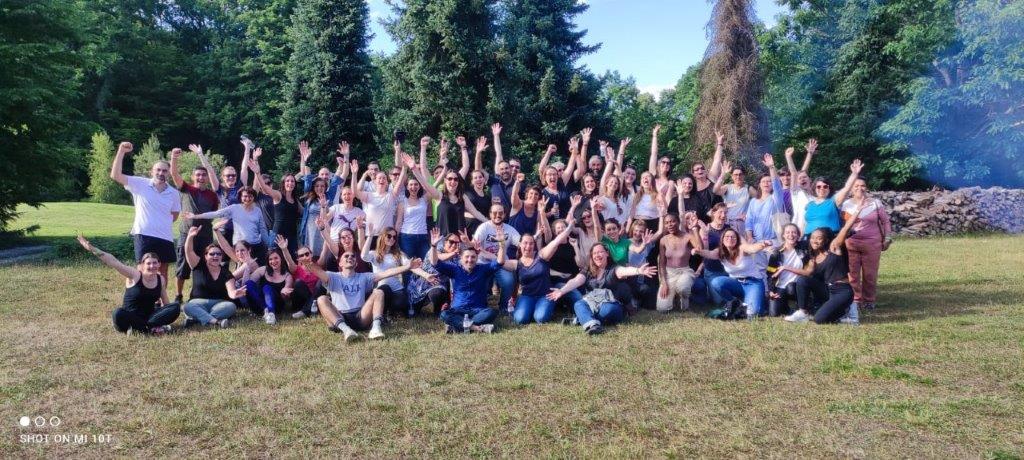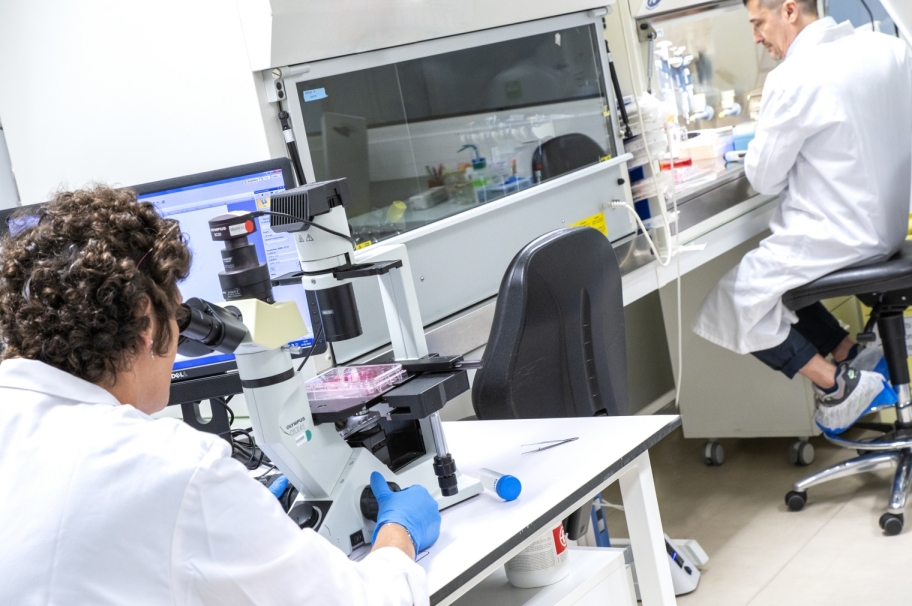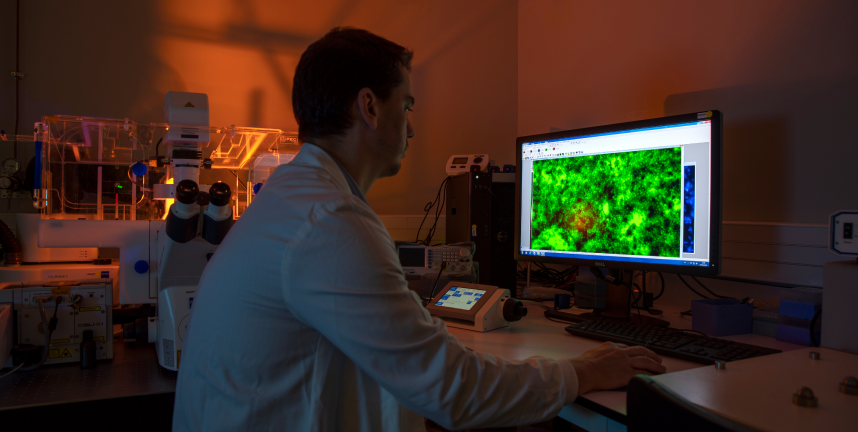Our organization
I-Stem is the result of the combination of two different and independent entities: a Joint Research Unit of Inserm and the University of Evry Val d’Essonne (UMR 861) and the Centre d’Etude des Cellules Souches (CECS) itself supported by the AFM-Telethon.
I-Stem is one of the three institutes directly associated with the AFM-Téléthon, its “armed arms”, which have been grouped together since 2012 in the Institute for Biotherapies. Until recently, I-Stem also received strong support from Genopole, which included its development as one of the site’s major projects in its successive strategic plans between 2005 and 2023.
The Institute articulates three different activities: fundamental biological research, technological and application research, and a biological and technological resource center. Each of these major types of activities has its own organizational framework, funding methods and partnerships, which are gradually being set up in a coordinated manner to ensure complementarity.
A fundamental biological research laboratory
I-Stem includes first of all a biological research laboratory, whose field is defined by practical purposes but which explores fundamental fields. The study of the potential therapeutic application of stem cells requires the characterization of their biological properties, the deciphering of the mechanisms underlying their pluripotency and differentiation, and the understanding of the signals that direct their destiny towards cellular phenotypes. Their use for therapeutic purposes requires, in particular, in the case of cell replacement therapies, the analysis of their integration capacities in damaged adult tissues and their tumorigenicity, and the development of original delivery routes. The application to monogenic diseases also covers multiple themes of fundamental research: definition of pathological mechanisms, identification of biomarkers, research of compounds likely to counteract phenotypic alterations linked to the presence of mutations causing monogenic diseases, definition of the molecular modes of action of these compounds.
The basic research laboratory relies on six teams dedicated to sets of pathologies allowing coordinated approaches.
Neuromuscular axis pathologies associated with dystrophic myotonia type 1, infantile spinal muscular atrophy and Wolfram syndrome (under the direction of Cécile Martinat), neurological disorders related to Steinert and Duchenne myopathies or Lesch-Nyhan syndrome (Alexandra Benchoua), limb-girdle myopathies (Xavier Nissan), genodermatoses (Christine Baldeschi), retinitis pigmentosa (Christelle Monville) and myelinated fiber diseases (Nicolas Tricaud).
A laboratory for research and technological development and application of therapies
I-Stem’s final objective is to make available to physicians and patients therapeutic products applied to monogenic diseases. It is therefore necessary to set up the circuits that go from discovery to application, i.e. coherent technological sets structured in an industrial-type framework that effectively allow, under the conditions required for human application, the development of therapeutic products. All these activities are carried out by about twenty engineers grouped in the “technological platforms” team (under the direction of Alexandra Benchoua). Their objectives are respectively: automated mass production of stem cells and their derivatives, cell culture and quality control methodologies, high throughput sequencing, high and medium throughput screening of compounds, microscopic and automated cell imaging.
The similarity between these activities and those carried out by many biotechnology companies is not accidental. In fact, I-Stem can be considered in part as a “not-for-profit biotech”, sharing the ground of activities of many private companies.
A center for biological and technological resources and know-how
I-Stem develops biological and technological resources as well as valuable know-how for its own purposes. We are able to offer these resources in collaboration, on site, to external research teams, both academic and industrial, whose objectives are different. I-Stem can provide them with a service activity, which can go as far as hosting so-called “temporary” contractual teams on the site. In agreement with its supervisor AFM-Telethon, I-Stem is able to devote up to 20% of its capacity to this service activity outside its own objectives restricted to monogenic diseases.
Organizational charts & Bodies
The CECS Board of Directors
The CECS Board of Directors is composed of representatives from AFM-Telethon, Genethon and AIM. Since June 17, 2022, it has been chaired by Christian Cottet.
UMR861 & CECS
I-Stem is the result of the combination of two different and independent entities: a Joint Research Unit of Inserm and the University of Evry Val d’Essonne (UMR 861) and the Center for the Study of Stem Cells (CECS) itself supported by the AFM-Telethon.
International Scientific Advisory Board
The International Scientific Council of I-Stem is composed of researchers, physicians and industrialists who accompany and advise I-Stem in its strategic scientific orientations.
Founder partners
In 1958, patients and their families came together in the AFM-Telethon with one goal: to cure neuromuscular diseases. Their strategy: to fight on all fronts of the disease, from scientific research to helping patients, and to implement a general interest strategy around genetic diseases and rare diseases. In 1987, to give itself the means to fight, it created the Telethon, which has since brought together millions of people every year to support the struggle of families.
Thanks to the mobilization of the Telethon, the AFM-Téléthon has become a major player in biomedical research for rare diseases in France and around the world. It supports more than 200 research programs each year as well as some thirty clinical trials concerning genetic diseases of the eyes, blood, brain, immune system, muscle, etc. It has created three laboratories that are at the forefront of research and development of innovative therapies: Genethon for gene therapy of rare diseases, the Institute of Myology for muscle and its diseases and I-Stem for stem cells and their therapeutic applications for genetic diseases.
UMR 861
40
UMR 861 is one of more than 40 research teams attached to the Paris Ile-de-France Sud INSERM regional delegation
INSERM
L’Institut national de la santé et de la recherche médicale has the mission to develop biological, medical and population health research, to ensure the dissemination of knowledge and know-how and to promote the results of its research.
More than 10,000 researchers, engineers, technicians and research managers, hospital practitioners, academics and students, 7,000 publications per year, 300 laboratories and 60 federative research institutes to improve health through research.
Evry-Val d’Essonne University
Évry-Val d’Essonne University (UEVE) is one of the four new universities created in 1991 as part of the development of higher education in the Ile-de-France region and the deconcentration of Parisian universities. Located in a growing urban area, the university has been a multidisciplinary university since its creation and has turned to professionalizing courses to meet the needs of its economic and social environment. The UEVE is now attached to the Université Paris-Saclay (UPSay), which opens up considerable new possibilities for mutualization and development.
With more than 150 courses on offer – more than half of which are professional in nature – it provides training in scientific and technological disciplines, in legal, economic and management disciplines, and in the human and social sciences. Recognized as a dynamic local structure that encourages rapid integration into working life, it currently has more than 10,400 students and meets the expectations of a wide range of students, both in initial and continuing education.
The university is also a major research center with 22 laboratories and two doctoral schools, and is involved in major research projects in and around life sciences in conjunction with Genopole®. Created in 1998 at the initiative of the French government, local authorities and the French Muscular Dystrophy Association, Genopole® is based on an original concept: bringing together academic and private research laboratories, biotech companies and high-level teaching in one place. Genopole®’s objective is to promote the development of large-scale biology and the creation of biotech companies in order to position France in a strong position in international scientific and industrial competition.
Genopole® has rapidly become a reference site. The campus currently brings together some twenty research laboratories and sixty biotechnology companies around the University of Evry-Val d’Essonne, which provides teaching in close liaison with the site’s research structures.
CECS
2005
Creation of the I-Stem laboratory
Le Centre d’Etude des Cellules Souches (CECS) is an association governed by the Law of 1901 which was created by the AFM-Téléthon, with the support of Genethon and the Institute of Myology, in order to ensure the development of the I-Stem Institute. The CECS employs engineers, researchers and support staff working within I-Stem in close collaboration with the academic teams of Inserm and the University of Evry-Val d’Essonne.
Our research areas
Teams that work “on projects” with specific therapeutic objectives.
The I-Stem laboratory is a structure dedicated to the exploration of the potential therapeutic applications of pluripotent stem cells. It is therefore presented in the scientific-medical continuum as an R&D center carrying out translational research, not as a fundamental research laboratory. This constant preoccupation with the therapeutic target is reflected in the organization of the teams around projects and schedules. Such an organization also allows us to test the scientific feasibility of operations since each schedule shows benchmarks, with precise objectives to be reached within a calculated timeframe.
I-Stem’s current scientific programs
We work along major lines of biological and technological research.
For the research teams oriented towards pathological targets, particular emphasis was initially placed on several monogenic pathologies involving specific cell populations of various organs, skeletal muscle, the central nervous system, the retina and the epidermis, or general phenomena such as premature aging. This choice, guided essentially by scientific opportunity, has been expanded as the Institute has grown.

As far as the cellular modeling of pathologies and pharmacological approaches are concerned, I-Stem’s ambition is to set up a technological research capable of covering all aspects of the development or discovery of molecules of therapeutic interest. On the basis of objectives defined by the clinical and epidemiological study of monogenic diseases, we aim to develop candidate compounds for clinical trials.
For research teams structured around pathological indications, as well as for those carrying out technological developments, industrial and academic partnerships are frequently set up.
Reasearch
Teams
I-Stem brings together within its research teams the expertise and know-how of researchers, teacher-researchers, engineers and technicians. Retinopathies, genodermatoses, Limb-girdle muscular dystrophies, neuromuscular diseases and myelinated fibers are part of our main scientific themes.
Trials
Clinics
Clinical trials are a crucial step in the development of treatments for any pathology. I-Stem is the sponsor of several trials and supports others through partnerships.
stemCARE
Technology plateform
Excellent research requires state-of-the-art equipment. I-Stem is equipped with technological platforms allowing its research teams to optimize their fundamental, pre-clinical and clinical research projects.



